#bisonhillock
Text
Internship adventures during summer ‘16
From June till October I have been doing my internship at the ‘Bison Hillock’ project in the south-western part of Romania. This internship was a part of my Master study Biology at the Wageningen University in The Netherlands, where one my teachers got me in contact with Rewilding Europe. They suggested to me to check out their rewilding project in the Southern Carpathians and connected me to the WWF Romania team that is working there. Soon it became clear that this project could really use an intern student, as there were special events about to happen, so I went for it!
In the beginning of June 2016 I arrived in a small and rural Romanian village called Fenes. Here, most people work on their lands in the surrounding hills, and with only one primary school, a few shops and a small monastery, many people spend their free time by sitting outside in front of their houses, watching as the day goes by. At first sight, it seems like nothing special is happing there, but there is! Fenes is home to the research station of the WWF Romania’s team members of the Bison Hillock project. The project is aimed to bring back the European bison (Bison bonasus) to the Romanian wilderness. As part of a bigger plan, these bison will be free to roam the largest European mountain range and hopefully connect with other reintroduced bison herds from several Eastern European countries to restore a viable and healthy bison population in Europe.
The rewilding takes place in stages, where bison are released into an enclosure with a so-called ‘acclimatization zone’ and ‘rewilding zone’, before being released into the wild. Just a few days after my arrival, the first 20 bison that were brought to this enclosure over the last years, were set free. This was great news and a big step forward in the project! Shortly afterwards a new group of 10 bison arrived from Belgium and Germany to rewild during the following months. Television crews from CNN, Belgium and Romania joined this event, as did the involved partners and locals. It was great to see that many people are interested and involved in this project!
With the first group of bison enjoying their freedom I was able to start my research. Because little is known about the bison behaviour in the wild, it was important to find out which places and habitats these bison preferred, described in terms of their habitat use. Would they move to the higher elevated mountainous forests and grasslands? Or maybe stick around the local farms and pastures? Collected data would not only provide information that can be used for adaptive management for example to prevent future human-bison conflicts, but also for the search of alternative reintroduction sites along the Carpathians to support the establishment of a healthy bison population. So, I used the available methods to collect data on where the bison were hanging around. I analysed GPS data from a collared bison, videos from camera traps in the study area, and coordinates from indirect bison observations by performing transects and other hikes. These indirect observations included the tracks and faeces of the bison, but also the damage to the bark of trees, as the bison like to nibble on the bark of young beech (Fagus sylvatica) and fir (Abies alba) saplings.
Every time I went up into the mountains to do my fieldwork research I felt privileged to be working in such a beautiful and wild place. Each week I hiked several tens of kilometres through the area to cover as much ground as possible to track the wild bison and conduct my research. Of course the bison are not the only wildlife that can be found there, as the camera traps have captured species of deer, wild boar, wolf, brown bear, and even the illusive Eurasian lynx! One time I even had a close encounter with a large mammal, hiding just 20 meters away in a dense beech-seedling patch. Although I couldn’t see what was running away from me, I found very fresh bear scats just a hundred meters away! But besides the fact that this was quite exciting it was actually very useful, as I was able to collect samples for another study on genetic diversity on the brown bear in the Southern Carpathians!
After collecting all my data I analysed it with statistical and GIS-software and I found several ‘hotspots’ where bison-activity was very high! Interestingly, some bison that were found often in these hotspots preferred pasture habitats and spend more than 70% of their time in this habitat type. Remarkably, these findings differ from studies on habitat use of the free bison in Poland, where they spent most of their time in forest habitats. But not all the bison were found in pastures, as many tracks were found in other (open) forest areas, indicating that another part of the group is expanding the home range and exploring the area. This is promising news and hopefully the bison will keep exploring to find their way across the mountains in the next years!
Besides doing research on the bison, the Bison Hillock project is also focussing on other aspects like involvement and development of local enterprises, raising awareness for nature conservation, and the establishment of nature-friendly tourism. During my time in Romania I’ve helped to set up a weekly movie-night for the local youth, where we mixed educative nature related documentaries with Disney movies to keep the kids involved and familiar with the project. Also the visitor centre in the neighbouring Armeniș village has been opened with state of the art installations where science is displayed to anyone interested. It even hosts Europe biggest hologram-projection, where you can see the bison moving around!
The Bison Hillock project has proven to me to be special and unique, a place you must visit if you are interested in the European wilderness! The project enables people to stand at the frontline of nature conservation and learn about its beauty and challenges. Personally, I have learnt a lot and I was happy to be able to teach other people who are involved in the project too! I am sure that more special events will take place in the upcoming years, so I would recommend everybody to support and visit this magnificent place in the green heart of Europe! I thank WWF Romania and Rewilding Europe once again for giving me the opportunity to join their work to make Europe a wilder place!
0 notes
Text
Vânători și ghizi, pe același drum spre conservare
Prima săptămână de toamnă a sosit în Măgura Zimbrilor alături de frunze ruginite și de vânturi răcoroase, cu mulți prieteni din țara și străinătate.
Echipei s-au alăturat, Nicolo, din Italia, care va fi busola tuturor pentru tot ce are legătură cu GIS (sistemul de informații geografice) și, de asemenea, cu Sebastian, ghid suedez, care se pregătește să devină principalul ghid local.
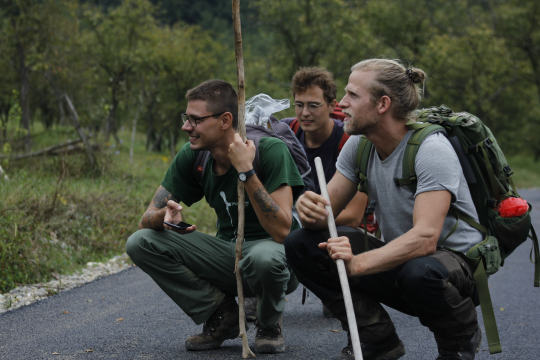
Nu s-a pierdut deloc timpul și Taskforece-ul a început explorarea regiunii, descoperind noi trasee și în același timp cunoscându-se mai bine reciproc.
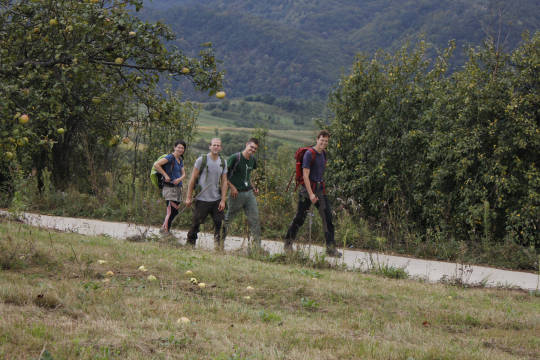
Curs de identificare a urmelor
Timp de 2 zile, un grup de 7 vânători din Armeniș a participat la un workshop de identificare a urmelor condus de Tony, expert în acest domeniu, cu 7 ani de experiență vastă acumulată în Africa și Europa.
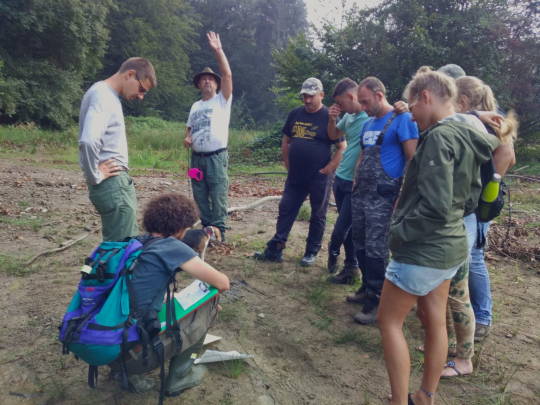
Vânătorii au lucrat independent și împreună pentru a recunoaște urme de păsări, rozătoare, canide și zimbru. Deși vânătorii sunt obișnuiți să urmeze numai anumite tipuri de piste în rutina obișnuită, acum ei pot urmări animale mai mici, cum ar fi gândacii și vidrele, care oferă o perspectivă mai detaliată asupra ecosistemului.
Unul dintre sfaturile pe care Tony le-a dat tuturor este să nu raționalizeze când văd o urmă. Uneori prima idee este cea mai bună.
O aplicație va fi dezvoltată pentru a fi utilizată de către vânători pentru a monitoriza urmele și fauna sălbatică. Acest exercițiu de urmărire și pașii următori joacă un rol important în consolidarea legăturii dintre programul de conservare și gestionarea corectă a animalelor sălbatice din păduri.

Curs de ghid
În același timp, un curs de ghid condus de Georg, care a fost principalul ghid în zonă în ultimii ani, a avut loc la Bison Hillock. Danne, Sebastian, doi ghizi locali Christian și Engelber alături de Lică și Ion, doi rangeri din Parcul Natural Vânători Neamț au petrecut 48 de ore prin pădure și au dormit sub stele la Observatorul Tara.
Cursul a fost axat pe urmărirea zimbrului și exercițiile de grup menite să crească gradul de conștientizare față de mediul înconjurător Într-unul dintre exerciții, ei au rămas tăcuți timp de trei sferturi de oră urmărind și ascultând natura.
„Aceste patruzeci de minute au dezvăluit care ar fi esența cursului de îndrumare. Expunându-ne la un mediu aparent neschimbat, simțurile noastre s-au trezit și au început să vadă și să audă ceea ce nu am observat anterior", a declarat Danne după ce experiența s-a încheiat.

Lecțiile învățate și conexiunile construite în această săptămână vor prospera, pentru a beneficia întreaga comunitate, programul de conservare și parteneriatele de lungă durată în țară și internațional.
For English please go here -> http://bisonhillock.tumblr.com/post/177869498706/hunters-and-guides-on-the-path-of-conservation
Text: Bianca Ștefanuț
Photos: Bianca Ștefanuț & Alina Floroi
0 notes
Photo

We had the pleasure of welcoming French nature photographer and bison enthusiast Anthony Porte to the Bison Hillock. Matei, our bison ranger showed him around and helped him to get familiar with the most frequented bison spots. Anthony has plenty of wildlife tracking experience, he is also a ranger in a national park so he preferred to take nature in at slow pace and without much hand holding. Here are his reflections on the days spent in the wild:
"These ten days spent on the field in the Bison Hillock have been a very good experience. I am used to searching and photographing the bison in the Bialowieza Forest in Poland, I can confirm that the bison in the Tarcu's mountains were wild and it took me six days to photograph them (despite good camouflage, many years of experience, and the advice of the rangers), their ability to smell me being decisive ... the bison are very mobile to find their food, many hours of walking in very cold conditions were necessary every day, giving a little more value to each image. Ten exceptional days in a wild landscape in the company of extraordinary animals thanks again to all the WWF Romania and Rewilding Europe team!”
Antony PORTE
Being in the presence of wild animals is a privilege and a reward every single time. If you too would like to give bison tracking a try you can get in touch with the team and plan a visit over the warm season » http://wwf.ro/visitbison
0 notes
Text
Faceți cunoștință cu echipa - Danne
Danne van Roon este din Olanda și a absolvit fizică teoretică și chimie teoretică și s-a alăturat Taskforce-ului pentru a se reîntoarce la natură și a descoperi aspectele practice ale vieții rurale.
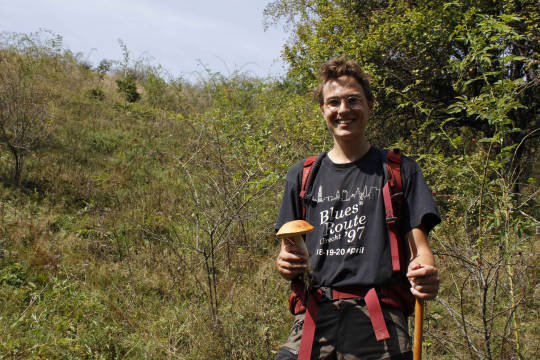
Impresii despre proiect
Apreciez mult proiectul care reintroduce zimbrul, bison bonasus, în munții Carpați, mă ajută să revin la lucrurile simple. E ceva ce am vrut să fac de mult, mi-a permis să studiez natura, nu numai în teorie, ci și cu simțurile mele. Biologia este un domeniu diferit de ceea ce am studiat, dar mă bucur cu adevărat de această experiență.
Rolul în echipă
În cadrul grupului de lucru niciun rol nu se limitează în întregime la un singur domeniu, dar ceea ce fac este în principal să lucrez la dezvoltarea ecoturismului, unde găsesc ce ar putea fi puncte de interes pentru potențialii turiști. Rolul include căutarea traseelor, apoi curățarea acestora, care este un lucru ce mă apropie mai mult de natură. Îmi place cu adevărat diversitatea proiectului, pentru că pot ajuta ceilalți membrii ai echipei la cercetarea comportamentului zimbrilor, dar și mergând în pădure pentru a determina tipul de vegetație consumată de zimbri.
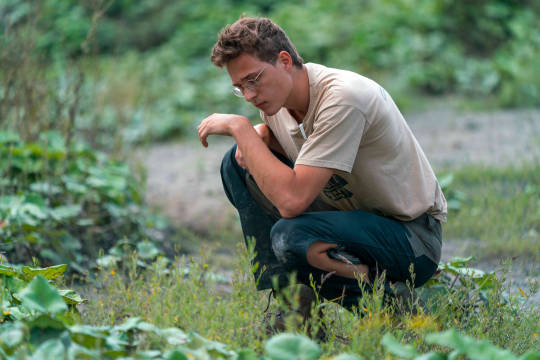
Planuri de viitor
Apreciez că lucrez la probleme din viața reală pentru a crea o schimbare. Este interesant să văd cât de dificile pot fi lucrurile în practică, decât să rezolv probleme doar pe hârtie. De asemenea, aici lucrez și cu natura, lucru pe care am vrut să îl fac de multă vreme. S-ar putea dovedi a fi un deschizător de ochi pentru mine, pentru a schimba direcția în viață într-un domeniu care îmi permite să lucrez în aer liber mai mult decât ceea ce am făcut anterior.
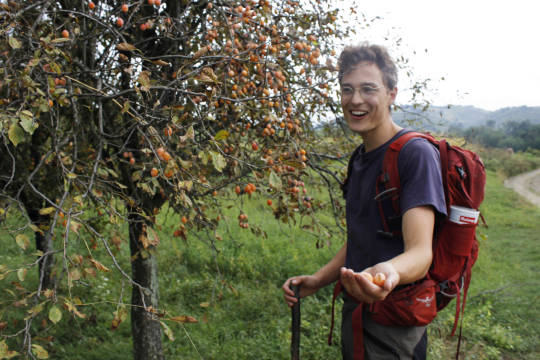
Hei lume!
Vizitați zona și vedeți-o. Este splendid aici. Toți oamenii care stau în fața calculatorului, bineînțeles că nu vă cunosc, dar un lucru pe care vi-l pot recomanda este să ieșiți afară. Lăsați-vă laptopul, telefonul sau orice alt computer și ieșiți pentru o vreme. Este balsam pentru suflet și distractiv. Cred că ar fi cu adevărat benefic pentru mulți oameni. Deci, închideți calculatorul după ce citiți acest articol și ieșiți din casă.
Descoperiți ce face restul Taskforce-ului în Măgura Zimbrilor urmând hashtag-ul nostru: #bisonhillocklive și canalele noastre.
For English please click here -> http://bisonhillock.tumblr.com/post/179004850281/meet-the-team-danne
Text: Bianca Ștefanuț
Fotografii: Bianca Ștefanuț & Daniel Mîrlea
0 notes
Text
Efort de echipă pentru a asigura viitorul zimbrului în Carpați
Călătorind peste 500 km pentru a întâlni, a învăța și a face schimb de bune practici cu primul Parc Natural care a reintrodus zimbrii în sălbăticie în România s-a dovedit a fi o experiență excepțională pentru echipa de interni.
După o scurtă oprire în Brașov pentru a admira frumusețea orașului îmbrațișatat de munți și pentru sărbătorirea zilei de naștere a colegei noastre Ariane, drumul ne-a purtat la Parcul Natural Vânători Neamț care se află în partea de nord a județului Neamț și se întinde pe 30.818 hectare, din care 26.190 hectare sunt de pădure.

Administrația parcului, condusă de domnul Sebastian Cătănoiu, a salutat călduros echipa Măgurii Zimbrilor, au vorbit despre stadiul proiectului de conservare și despre imensul progres înregistrat atât în Vânători Neamț, cât și în Armeniș.
Vânători Neamț este singurul parc unde zimbrul poate fi găsit liber (37 zimbri) într-o incintă de aclimatizare (12 zimbri) și, de asemenea, în captivitate, ca parte a grădinii zoologice a comunei Vânători.
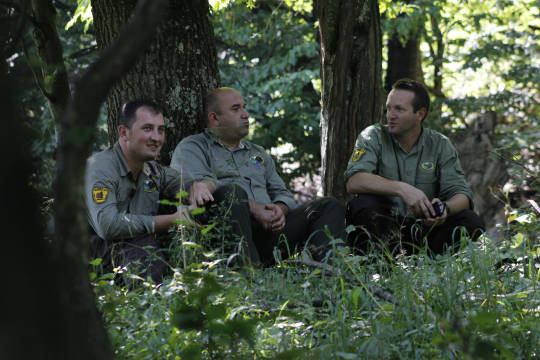
Rangerii i-au ajutat pe noii veniți să descopere cele 80 de hectare de aclimatizare și nu le-a fost mică surpriza de a nimeri față în față cu un mascul de zimbru la începutul călătoriei, devorând fân. Ne-am uitat unul la altul pentru ceea ce părea a fi un moment suspendat în timp, după care ambele părți și-au făcut drum prin pădurea seculară.
Următoarea întâlnire nu a fost mai puțin impresionantă cu un mascul odihnindu-se și lăsând pe toată lumea să-l privească de la mai puțin de 10 metri, în timp ce el lenevea înlăturând muștele cu coada. Ariane a surprins momentul cu aceasta fotografie deosebită.
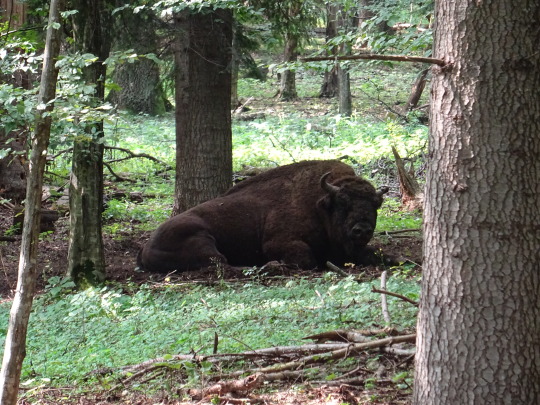
Echipa a adunat informații despre starea colectivului din grup, 10 bizon cu doi viței de anul trecut, condusă de o femeie alfa și de un mascul și de cei doi masculi solitari care se perindă în incintă. De asemenea, au fost bucuroși să audă despre zimbrii care se află în sălbăticie, din care doi masculi poartă gulere de urmărire, facilitând astfel monitorizarea lor.
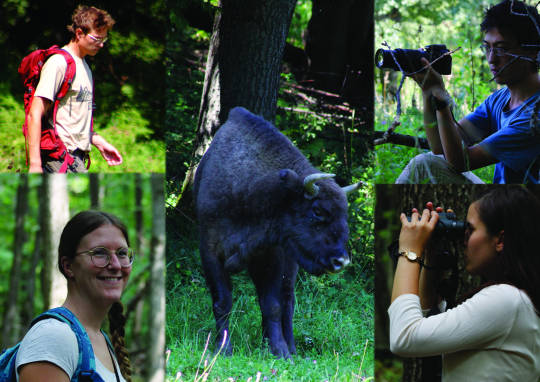
O veste bună este întotdeauna binevenită, iar povestea unui vițel născut în decembrie 2012, care este acum o mamă in devenire i-a bucurat pe stagiarii care au visat probabil la prima oară când vor fi martorii unei nașteri în sălbăticie.
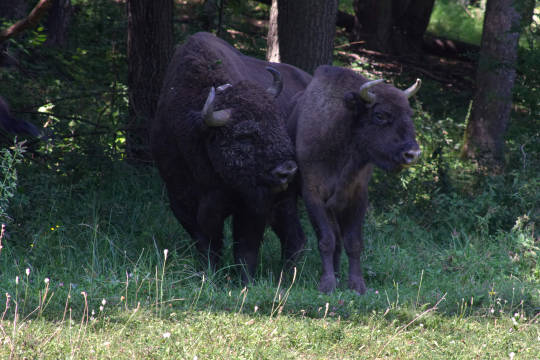
Săptămâna s-a încheiat cu echipa ghidând un echipaj de filmare care intenționa să surprindă rolul zimbrului în modelarea ecosistemului. Lista cadrelor dorite părea dificil de realizat, dar datorită cunoștințelor prețioase ale rangerilor din Vânători Neamț și strategia stabilită într-o rundă de practică, trei echipe au pornit să găsească creaturile impunătoare.
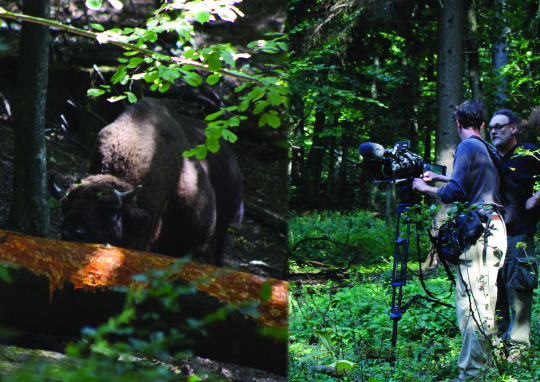
Un mascul de peste 8 ani ne-a oferit o imagine deosebită – devorând scoarța unui cireș căzut, dar momentul de impact a fost turma care ne-a permis să ne apropiem foarte mult. Observându-i comportamentul, băile de praf, mănâncând într-o poiență și în pădure.
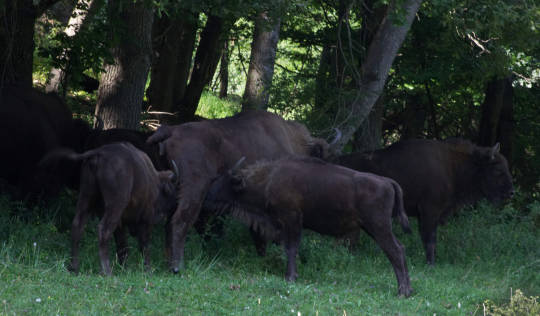
Observarea a doi viței care se alăptează, în vârstă de un an și respectiv doi ani, ne-au lăsat pe toți, chiar și pe rangeri, fără suflare și uimiți.
Ce șansă deosebită pentru ehipa din Măgura Zimbrilor de a analiza comportamentul grupului și de a înțelege mai bine toate legăturile dintre aceste creaturi maiestuoase și mediul lor. Cu toții dorim clădirea acestui vis de a vedea zimbrii deplasându-se pe întregul lanț Carpatic. Astfel dezvoltăm împreună proiectul WildAI prin cercetare, studii comparative și integrarea datelor.
Text și fotografii: Bianca Ştefănuț
For English please go here -> http://bisonhillock.tumblr.com/post/177441341721/team-effort-to-ensure-the-future-of-wild-bison-in
#bisonhillock#magurazimbrilorlive#zimbri#bison#rewildingeurope#rewildingromania#parculnaturalvanatorineamt
0 notes
Text
Ignition for a visionary platform for wildlife monitoring in the Carpathian Mountains
Bucharest, 23.07.2018
WildAI [eye], a project dedicated to innovative wildlife monitoring in the Carpathians, has officially started through a partners’ meeting that took place at WWF headquarters in Zurich. Through the pilot programme, the vision is to gather and analyse into a single platform multi-sensor data in real time in order to inform management decisions and scientific knowledge that can benefit not only wildlife, but also local economies in the Carpathians and beyond, in a truly integrated nature-tech project.

Europe has few places where nature is still preserved in its wildest state. These wild areas have a major impact on the wellbeing of our natural environment, but their resilience relies on making informed decisions which help to balance the goods and services wild nature provides. The pilot programme will have in view the Southern Carpathians located in Romania, with a special focus on a Natura 2000 site of 59,000 ha, the Tarcu Mountains, home to an ambitious European bison rewilding initiative.
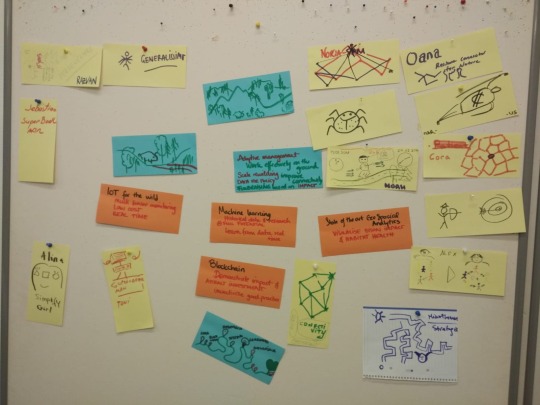
WildAI [eye] envisions increasing the impact of wildlife monitoring, by designing an AI (artificial intelligence) system that contains small GPS trackers that can be attached to bison and large carnivores and other large mammals. This project is the launch-pad to produce cost-effective tools for large-scale wildlife monitoring adapted to the tricky terrain in the Carpathians. Automated data acquisition from the field will help address challenges faced by managers of protected areas who have used tools that depend of the accuracy of data and limited physical resources. It will be a great resource for scientists too, who will be able to design studies of the species and habitats more accurately and draw conclusions on further introductions of bison in the wild. Furthermore, there is a need to replace expensive collars connected to satellite with a cheaper and real time solution.
The monitoring will be made through wearable GPS trackers based on LoRaWAN radio networking technology that sends information to a cloud (server) about the position of the bison. Through labeling information in databases and combining inputs about weather conditions, altitude, vegetation, the system will enable data analysts to interpret and contextualise bison behaviour. The GIS (Geographic Information System) platform will generate complex map visualizations and inform management decisions. Blockchain will be an interesting addition, since there is a big need to evaluate the potential investments in the area from people interested to protect nature. This could be achieved by translating the value of ecological services in the area.

Besides a strong international presence from WWF International and WWF Switzerland, with WWF-Romania as the testing ground and expert support from bison specialists of Vanatori Neamt Nature Park, the first bison rewilding site in Romania, the launch meeting was joined by the hardware partner Miromico in charge of IoT integration (Internet of Things) and representatives of Porini Foundation and ETH Zurich, that are promoting blockchain in sustainability systems. Miromico is the winner of seed funding through a challenge raised by WWF-Romania and supported by Impact Hub as part of a Horizon 2020 programme. Boutique data science consultancy Ars Analitica took part in the launch meeting remotely, to instil a better understanding of how much further we can get with predictions made with the help of machine learning (AI). The partnership is joined by ESRI, a global authority in GIS.
A team of 6 young professionals from Belgium, the Netherlands, Italy, Romania and Sweden are coming on the frontlines of this project as a field resource for the international multi-disciplinary team described above. The 6 interns are part of WWF’s Bison Hillock field research programme started in 2016 with financial support from the Swiss-Romanian Cooperation Programme and now maintained annually through a grant from WWF International’s Volunteering Programme.
“We full heartedly believe that bison rewilding offers a unique opportunity to design a systemic intervention at landscape level, starting with this keystone species and the valuable wilderness of the Carpathian ecoregion”, says project driver Oana Mondoc of WWF-Romania.
WildAI [eye] counts to find further financial support in the future by demonstrating the impact of bison to the world and close the loop by jig staring a local micro economy designed around the wellbeing of wild nature. The Carpathian Mountains are one of Europe’s richest biodiversity reservoirs, where emblematic species like the brown bear, grey wolf, Eurasian lynx and, recently, the European bison live. In 2013, WWF and Rewilding Europe started an ambitious bison rewilding initiative in the Tarcu Mountains in Romania. The bison, as a wild large herbivore, is a key instrument for naturally restoring degraded or vulnerable areas, as they help maintain the diversity and richness of these landscapes, by creating corridors for the movement of other animals through its browsing capacity and big home range.
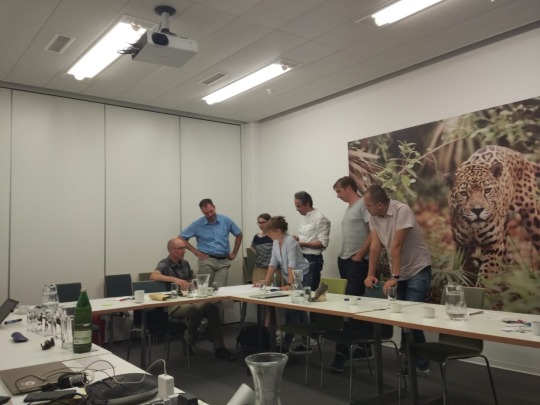
WildAI [eye] is WWF-Romania’s first pilot as a “Panda Lab”. Through Panda Labs, WWF works with technology, business, design, academia and conservation to develop new approaches of solving our planet's most stringent problems. Panda Lab is to become WWF Romania’s decentralised accelerator, a community for problem-solving aiming to attract partners and finance gradually.
You can keep an eye on the initiative here and don’t hesitate to get in touch with the team.

1 note
·
View note
Text
Young researchers in the Bison Hillock
We want to introduce to you three new members of our team, young researchers undertaking an internship with Rewilding Europe and WWF Romania, studying various aspects of the bison rewilding initiative in the Southern Carpathians. You can read a little bit about them, in their own words...
Georg Messerer from Germany
“I came back to Germany after spending some time guiding safaris and learning about the african ecology in South Africa and Botswana last year. I then wanted to apply my experiences in Europe and was disappointed to not find a single intact ecosystem in Germany. I then searched for projects and came across projects to rewild europe in different countries. Romania immediately struck me as the most interesting, since I have never been there, and I was told the wilderness in the Carpathians is the most pristine in Europe. So I was sold and after getting everything organised through the local team managers, I came as soon as possible. And now, after being here and seeing it myself, I don't plan to leave any time soon and hope to contribute my part towards it”
Tiago de Matos Miguel from Portugal
“My name is Tiago, I'm Portuguese and I've been studying in Holland for over 2 years. I came to the Bison Hillock as part of my Masters Internship on Forest and Nature Conservation and because I'm passionate about wildlife. I was eager to find how this ambitious project was working and help out in what I can, while at the same time conduct my own research project. I am currently working with camera traps to get an idea of the fauna composition in the area where the bison are to be released. Projects like this deserve the full attention and support of the European audience, and I could not help myself but take part in bringing the European bison, that wonderful beast, back to the European landscape where it once roamed wild and forever belongs.”
Clare Bissell from the UK
“I'm a full time masters student at University College London, studying Anthropology, Environment and Development. I was attracted to the bison project here in Armeniș because it sounded like an interesting place to explore in person a lot of the topics I have been studying - the balance of conservation with development, the social and economic situation, and what local people think about 'rewilding' as a concept. During my stay I hope to talk to people to learn about their way of life (hopefully getting hands on experience) and to research how far locals feel ownership over the bison project direction, priorities and development. I am also interested in the political background and the pressure from other forms of 'development' in the area. My professional background is in working with communities in the UK, setting up and running community/youth-led projects in London and Bedford.”
You can keep up to date with their work, right here on our blog. Follow us, for the latest filed updates from the Bison Hillock.
0 notes